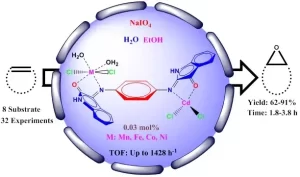
The development of an appropriate kinetic model for cracking reactions is essential for simulation and process optimization. These results are to be potentially used for proper reactor design. The complexities of oil gas inlet combinations have led to an increase in the challenges while defining and depicting kinetics on an intrinsic scale. Hence, complicated chemical […]
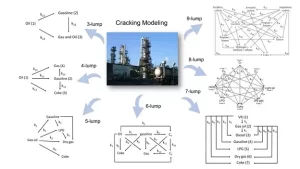
A novel organic-inorganic hybrid nanomaterial namely nano-[SiO2@R-Im-SO3H][CF3COO] (NSRISC) was synthesized, and characterized using FT-IR, EDS, FE-SEM, TGA and XRD analyses. Thereafter, the solvent-free production of bis-coumarins (from aryl aldehydes and 4-hydroxycoumarin) and N,N′-alkylidene bisamides (from aryl aldehydes and benzamide) was catalyzed by NSRISC. Bis-coumarins were produced in 86-97% at 100 ºC, and bisamides were obtained […]
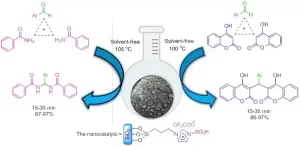
Green chemistry has fostered research on recyclable, insoluble, and easily separable heterogeneous catalysts. Carbon materials are widely used for renewable energy and environmental studies. Here, we used green Pistachio peel, a biomass waste for the synthesis of magnetic carbon-based solid acid (Fe3O4@C-SO3H) by carbonization and sulfonation. The physicochemical properties of the nanocatalyst were characterized using […]
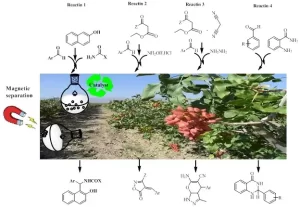
Zinc Oxide nanoparticles (ZnONPs), which have well-known antimicrobial properties, are used extensively in various medical and general applications. In this analysis, 70-gram positive bacterial isolates were obtained from 100 patients using cardiac catheterization, with 54 Staphylococcus aureus and 16 other positive pathogenic bacteria. Accordingly, morphological, cultural and biochemical testes confirmed the results by VITEK 2 […]
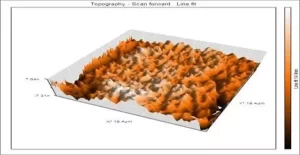
A supported magnetic nanocomposite as a simple, stable, and efficient catalyst was successfully developed for condensation reaction of aldehydes, ammonium acetate, and isatoic anhydride to prepare 2,3-dihydroquinazolin-4(1H)-one derivatives as essential biologically active heterocyclic compounds. Ethanol as a non-toxic solvent under a reflux condition was utilized in the reactions. The Fe3O4/SiO2/CeO2 nanocomposite was prepared as a […]
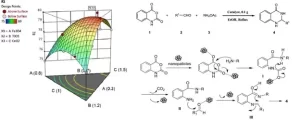
In the present paper, a novel thermal plasma method is proposed to synthesize ZnO-Fe2O3 nanocomposite, with different percentages of iron, namely 3, 5, and 7%. This method is an efficient feasibility of the Zno-Fe2O3 nanocomposite synthesis. The nanocomposites are synthesized by homemade direct current (DC) plasma torch. They are analyzed by different methods. The bandgap […]
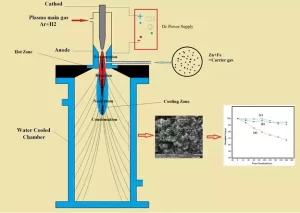
This study is the first report of the application of sulfonated multi-walled carbon nanotubes (MWCNTs-SO3H) in the synthesis of tetrahydrobenzo[a]xanthene and tetrahydrobenzo[a]acridine derivatives. The catalyst was prepared via a chemical approach and the sulfonated groups were attached to the side-wall of MWCNTs with total density of 2.58 mmol.g-1. In order to prove functionalization of the […]
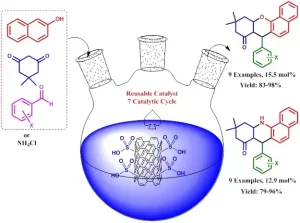
Mesoporous silica nanoparticles (MSNs) were synthesized hydrothermally and modified with Co2+ and Zn2+. The as-prepared samples were denoted as MSN, Co-MSN(X), and Zn-MSN(X), where X is the Si/M molar ratio. In addition, co-modified MSN samples with both cations were also prepared and denoted as Co-Zn(Y)-MSN(X), where Y indicates the Zn2+ content in the range of […]
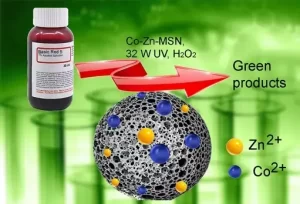
In the current study, a new methodology for the epoxidation of alkenes was developed. In this regard, the required ligand was synthesized from the reaction of isatin and 1,4-phenylenediamine to afford (3Z,3’Z)-3,3′-(1,4-phenylenebis(azaneylylidene))bis(indolin-2-one) ligand. Then, the two coordinate ligands were metallated using Cd and Mn/Fe/Co/Ni to obtain a series of hybrid dual metallic complexes containing (Cd […]
